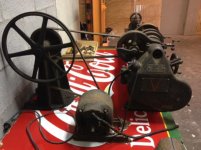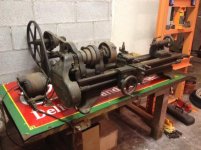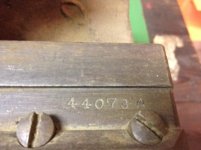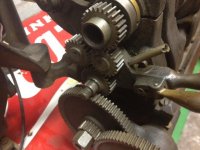jmills
Plastic
- Joined
- Apr 22, 2013
- Location
- Charleston, SC
This is my first post on this forum and I am new to the lathe world. I have been reading a little and this appears to be where all the experts hang out.  I am mechanically inclined and not afraid to get my hands dirty, but I will be the first to admit that I know almost zero about lathes. That being said, I am a quick learner and look forward to learning about this new addition to the garage.
I am mechanically inclined and not afraid to get my hands dirty, but I will be the first to admit that I know almost zero about lathes. That being said, I am a quick learner and look forward to learning about this new addition to the garage.
This past weekend, I finally was able to rescue a South Bend lathe that has been sitting in my dad's garage for the past ~25 years. The lathe has an interesting history and I have wanted to get it running for a long time, but haven't had the space.
According to South Bend, it was manufactured in 1929. My grandfather (who passed away long before I was born) originally bought the lathe for machinery maintenance in the Coca Cola bottling company that he managed in Louisiana. You will notice the Coke sign that covers the table the lathe is mounted on. I don't know if he bought the lathe new or exactly when it was purchased. If he bought it used, it was probably in the 1930's. When he passed away in the mid 1950's, my dad's guardian gave it a home and it eventually made it's way to Tennessee. About 25 years ago, my dad wanted to get the lathe so he did not loose control of it, so we brought it back to SC. It has been sitting in his garage collecting dust ever since.
I have no idea when it was last run, but it is good to see it out in the open and not stuck back in a corner. I’ll admit that I haven’t done much searching, but I am a little at a loss of where to even start. I figure it needs to be disassembled, cleaned and oiled, but wanted to get people’s thoughts before I got any hair brain ideas.
I would love to hear people's input on what exactly I have and what steps need to be taken to get it operational. I have read that the motor may need to be replaced or changes made and I imagine the oil is long since gone. For these reasons, I have not even tried to power it up.
Below are some pictures. I tried to embed the photos, but apparently I couldn't make it work. I'll be glad to take any additional photos.





Thanks again
Joe
 I am mechanically inclined and not afraid to get my hands dirty, but I will be the first to admit that I know almost zero about lathes. That being said, I am a quick learner and look forward to learning about this new addition to the garage.
I am mechanically inclined and not afraid to get my hands dirty, but I will be the first to admit that I know almost zero about lathes. That being said, I am a quick learner and look forward to learning about this new addition to the garage. This past weekend, I finally was able to rescue a South Bend lathe that has been sitting in my dad's garage for the past ~25 years. The lathe has an interesting history and I have wanted to get it running for a long time, but haven't had the space.
According to South Bend, it was manufactured in 1929. My grandfather (who passed away long before I was born) originally bought the lathe for machinery maintenance in the Coca Cola bottling company that he managed in Louisiana. You will notice the Coke sign that covers the table the lathe is mounted on. I don't know if he bought the lathe new or exactly when it was purchased. If he bought it used, it was probably in the 1930's. When he passed away in the mid 1950's, my dad's guardian gave it a home and it eventually made it's way to Tennessee. About 25 years ago, my dad wanted to get the lathe so he did not loose control of it, so we brought it back to SC. It has been sitting in his garage collecting dust ever since.
I have no idea when it was last run, but it is good to see it out in the open and not stuck back in a corner. I’ll admit that I haven’t done much searching, but I am a little at a loss of where to even start. I figure it needs to be disassembled, cleaned and oiled, but wanted to get people’s thoughts before I got any hair brain ideas.

I would love to hear people's input on what exactly I have and what steps need to be taken to get it operational. I have read that the motor may need to be replaced or changes made and I imagine the oil is long since gone. For these reasons, I have not even tried to power it up.
Below are some pictures. I tried to embed the photos, but apparently I couldn't make it work. I'll be glad to take any additional photos.





Thanks again
Joe











